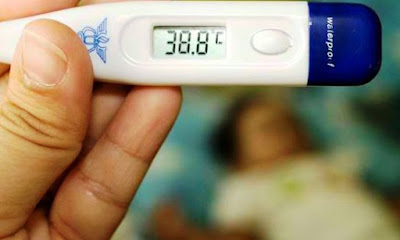How to take your child temperature?

Practice feeling your child's temperature by placing the palm of your hand on her forehead or by kissing her forehead so that you used to tell when she has a fever. Then confirm it by taking her temperature with a thermometer.
When your child is running a fever, keep a temperature chart by writing down the time, your child's temperature, and the method you have used to treat the fever. You can take your child's temperature in four part of her body, the rectum (rectal), the armpit (axillary), the mouth (oral), and the ear. Rectal temperature is one-half to one degree higher than oral temperature, and axillary temperature is usually one degree lower than oral. Follow the following guidelines and steps on how to take your child's rectal temperature.
Guide to take rectal child's temperature
- Use a rectal thermometer (one with a rounded, stubby end that is marked "rectal").
- Shake down the thermometer with a wrist - snapping motion until the mercury column is below 95 degrees Fahrenheit.
- Lubricate the bulb end with petroleum jelly.
- Lay your child face down across your lap and get her to relax. Reassure her that you won't hurt her. If she's old enough to understand, tell her to take a big breaths through her mouth.
- Gently insert the thermometer bulb only about one inch into the rectum, allowing the thermometer to seeks its own path. Don't force it.
- Hold the thermometer in place between your index and middle fingers with the palm of your hand and your fingers grasping your child's buttocks. By holding your child in her position you can hold the thermometer and keep your child from moving. Never leave a child alone with a thermometer in place.
- Try to keep the thermometer in place for three minutes. The rectal reading will be within a degree of true temperature after one minute.
A child more than five years of age will usually cooperate with having his temperature taken orally. Follow these three steps;
Steps to take temperature orally
- Use an oral thermometer (the oral thermometer has a longer, thinner bulb than the rectal thermometer and is marked "oral"). Shake down the thermometer with a wrist - snapping motion until the mercury column is below 95 degrees Fahrenheit.
- Have the child lie or sit quietly and place the end of the thermometer under her tongue, slightly to one side. Instruct your child to keep her mouth closed and to close her lips firmly, but not hold the thermometer with her teeth. Allowing the child to open her mouth to breathe with the thermometer in place will make the temperature reading inaccurate. If she can't breathe through her nose, take a rectal or axillary temperature.
- Try to keep the thermometer in place with mouth closed for two to three minutes
If your child resists having her temperature taken rectally or orally, you can take an axillary reading. An oral thermometer should be used for taking an axillary temperature, but four minutes is required to achieve an accurate temperature reading. Simply place the bulb right in the center of the armpit and secure it there by holding your child's arm across her chest as she sits on your lap.
The electronic thermometer are easier to read because of the digital display, but some are not accurate. While the ear thermometers are quite expensive, but they are very easy and quick to use.



Mga Komento
Mag-post ng isang Komento